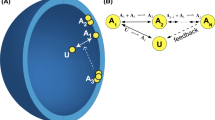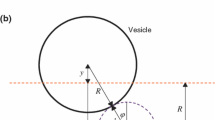Abstract
The process of ligand binding to a cluster of membrane-associated receptors is examined theoretically. The theoretical model proposed involves the diffusion of ligands from the solution to the disc-like cluster of receptors on the surface of the spherical cell. When the ligand hits the internal part of the disc-like cluster, it begins to move laterally until it leaves the disc through its outer surface or is bound by one of the receptors inside the disc. If the ligand leaves the cluster, it returns to the solution and hits the disc again after a certain period, etc. According to our model the transition from a diffusion-limited to a reaction-limited process of binding is determined by the dimensionless parameter λ ≡Dt c/a 2, where D is the lateral diffusion coefficient,t c is the characteristic time of reaction, anda is the radius of the disc-like cluster. The forward rate constantk f turns out to be a function of λ. Comparing the results of our calculations ofk f with some experimental data we found that agreement is achieved at high γ, i.e. the process of ligand binding by clustered receptors is predominantly reaction-limited.
Similar content being viewed by others
References
Abbott AJ, Nelsestuen GL (1989) The collisional limit: an important consideration for membrane-associated enzymes and receptors. FASEB J 2:2858–2866
Bell GI (1978) Models for the specific adhesion of cells to cells. Science 200:618–627
Berg HC, Purcell EM (1977) Physics of chemoreception. Biophys J 20:193–219
DeLisi C (1981) The effect of cell size and receptor density on ligandreceptor reaction rate constants. Mol Immunol 18:507–511
Dewey TG, Datta MM (1989) Determination of the fractal dimension of membrane protein aggregates using fluorerscence energy transfer. Biophys J 56:415–420
Eigen M (1974) Diffusion control in biochemical reactions. In: Quantum statistical mechanics in the natural sciences. Mintz SL, Wiedermayer SM (eds) Plenum Press, New York, pp 37–61
Erickson J, Goldstein B, Holowka D, Baird B (1987) The effect of receptor density on the forward rate constant for binding of ligands to cell surface receptors. Biophys J 52:657–662
Goldstein B (1989) Diffusion limited effects of receptor clustering. Comments Theor Biol 1: 109–127.
Goldstein B, Wiegel FW (1983) The effect of receptor clustering on diffusion limited forward rate constants. Biophys J 43:121–125
Hill TL (1975) Effect of rotation on the diffusion-controlled rate ligand-protein association. Proc Natl Acad Sci USA 72:4918–4922
Kaprelyants AS (1988) Dynamic spatial distribution of protein in the cell. Trends Biochem Sci 13:43–46
Morse PM, Feschbach H (1953) Methods of theoretical physics. McGraw-Hill, New York
Pecht I, Lancet O (1977) Kinetics of antibody-hapten interaction. In: Chemical relaxation in molecular biology. Pecht I, Ringler R (eds) Springer, New York Berlin Heidelberg
Posner RG, Lee B, Conrad DH, Holowka D, Baird B, Goldstein B (1992) Aggregation of IgE-receptor complexes on rat basophilic leukemia cells does not change the intrinsic affinity but can alter the kinetics of the ligand-IgE interaction. Biochemistry 31: 5350–5356
Ryan TA, Menon AK, Holowka D, Baird B, Webb WW (1986) Inter-receptor spacing in IgE aggregates on the surface of RBL cells. Biophys J 49:360a
Ryan TA, Myers J, Holowka D, Baird B, Webb W (1988) Molecular crowding on the cell surface. Science 239:61–64
Shoup D, Szabo A (1982) Role of diffusion in ligand binding to macromolecules and cell-bound receptors. Biophys 40:33–39
Torney DC, Bell GI (1986) Thermodynamics of cell adhesion. II. Freely mobile repellers. Biophys J 49:501–507
Timoshenko AV, Cherenkevich SN (1990) Clusters of membrane receptors and their movement in cells. Uspechi Sovr Biologii 109:206–228 (in Russian)
Tozeren A (1990) Cell-cell conjugation. Transient analysis and experimental implications. Biophys J 58:641–652
Varfolomeyev SD, Zaitsev SV (1982) Kinetic methods in biochemical investigations. MGU, Moscow (in Russian)
Wiegel FW (1991) Physical principles in chemoreception. (Lect Notes Biomathematics) N91. Springer, Berlin Heidelberg New York
Author information
Authors and Affiliations
Rights and permissions
About this article
Cite this article
Potanin, A.A., Vladyslav, V., Belokoneva, O.S. et al. Kinetics of ligand binding to a cluster of membrane-associated receptors. Eur Biophys J 23, 197–205 (1994). https://doi.org/10.1007/BF01007611
Received:
Revised:
Issue Date:
DOI: https://doi.org/10.1007/BF01007611




